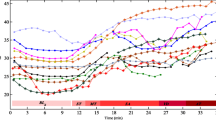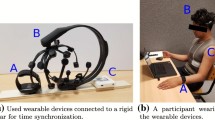Abstract
The aim of this study was to design a system to diagnose chronic stress, based on blunted reactivity of the autonomic nervous system (ANS) to cognitive load (CL). The system concurrently measures CL-induced variations in pupil diameter (PD), heart rate (HR), pulse wave amplitude (PWA), galvanic skin response (GSR), and breathing rate (BR). Measurements were recorded from 58 volunteers whose stress level was identified using the State-Trait Anxiety Inventory. Number-multiplication questions were used as CLs. HR, PWA, GSR, and PD were significantly (p < 0.05) changed during CL. CL-induced changes in PWA (16.87 ± 21.39), GSR (− 13.71 ± 7.86), and PD (11.56 ± 9.85) for non-stressed subjects (n = 36) were significantly different (p < 0.05) from those in PWA (2.92 ± 12.89), GSR (− 6.87 ± 9.54), and PD (4.51 ± 10.94) for stressed subjects (n = 22). ROC analysis for PWA, GSR, and PD illustrated their usefulness to identify stressed subjects. By inputting all features to different classification algorithms, up to 91.7% of sensitivity and 89.7% of accuracy to identify stressed subjects were achieved using 10-fold cross-validation. This study was the first to document blunted CL-induced changes in PWA, GSR, and PD in stressed subjects, compared to those in non-stressed subjects. Preliminary results demonstrated the ability of our system to objectively detect chronic stress with good accuracy, suggesting the potential for monitoring stress to prevent dangerous stress-related diseases.

Chronic stress degrads the autonomic nervous system reaction to cognitive loads. Measurement of reduced changes in physiological signals during asking math questions was useful to identify people with high STAI score (stressed subjects)








Similar content being viewed by others
Abbreviations
- ANS:
-
Autonomic nervous system
- BR:
-
Breathing rate
- CL:
-
Cognitive load
- ECG:
-
Electrocardiogram
- EMG:
-
Electromyogram
- GSR:
-
Galvanic skin response
- HR:
-
Heart rate
- HRV:
-
Heart rate variability
- PD:
-
Pupil diameter
- PPG:
-
Photoplethysmography
- PWA:
-
Pulse wave amplitude
- SNS:
-
Sympathetic nervous system
- STAI:
-
State Trait Anxiety Inventory
References
Alberdi A, Aztiria A, Basarab A (2016) Towards an automatic early stress recognition system for office environments based on multimodal measurements: a review. J Biomed Inform 59(Feb. 2016):49–75. https://doi.org/10.1016/j.jbi.2015.11.007
Barnes LLB, Harp D, Jung WS (2002) Reliability generalization of scores on the Spielberger’s State-Trait Anxiety Inventory. Educ Psychol Meas 62(4):603–618. https://doi.org/10.1177/0013164402062004005
Bauer AM, Quas JA, Boyce WT (2002) Associations between physiological reactivity and children’s behavior: advantages of a multisystem approach. J Dev Behav Pediatr 23(2):102–113
Beaty J, Lucero-Wagoner B (2000) The pupillary system. Handbook of Psychophysiology. Cambridge University Press, Cambridge, pp 142–162
Bell AC, D’Zurilla TJ (2009) The influence of social problem-solving ability on the relationship between daily stress and adjustment. Cogn Ther Res 33(5):439–448. https://doi.org/10.1007/s10608-009-9256-8
Braga-Neto U, Hashimoto R, Dougherty ER, Nguyen DV, Carroll RJ (2004) Is cross-validation better than resubstitution for ranking genes? Bioinformatics 20(2):253–258
Caravaca J, Soria-Olivas E, Bataller M, Serrano AJ, Such-Miquel L, Vila-Francés J, Guerrero JF (2014) Application of machine learning techniques to analyse the effects of physical exercise in ventricular fibrillation. Comput Biol Med 45:1–7. https://doi.org/10.1016/j.compbiomed.2013.11.008
Eisenberg D, Gollust SE, Golberstein E, Hefner JL (2007) Prevalence and correlates of depression, anxiety, and suicidality among university students. Am J Orthopsychiatry 77(4):534–542. https://doi.org/10.1037/0002-9432.77.4.534
Frank E, Hall MA, Witten IH (2016) The WEKA Workbench. Online appendix for data mining: practical machine learning tools and techniques, 4th edn. Morgan Kaufmann, San Francisco
Grös DF, Antony MM, Simms LJ, McCabe RE (2007) Psychometric properties of the State-Trait Inventory for Cognitive and Somatic Anxiety (STICSA): comparison to the State-Trait Anxiety Inventory (STAI). Psychol Assess 19(4):369–381. https://doi.org/10.1037/1040-3590.19.4.369
Hayashi T, Okamoto E, Nishimura H, Mizuno-Matsumoto Y, Ishii R, Ukai S (2013) Beta activities in EEG associated with emotional stress. International Journal of Intelligent Computing in Medical Sciences & Image Processing 3:57–68. https://doi.org/10.1080/1931308X.2009.10644171
Haykin SS and Haykin SS (2009) Neural networks and learning machines. Prentice Hall
Healey JA, Picard RW (2005) Detecting stress during real-world driving tasks using physiological sensors. IEEE Trans Intell Transp Syst 6(2):156–166. https://doi.org/10.1109/TITS.2005.848368
Hjortskov N, Garde AH, Ørbæk P, Hansen ÅM (2004) Evaluation of salivary cortisol as a biomarker of self-reported mental stress in field studies. Stress Health 20(2):91–98. https://doi.org/10.1002/smi.1000
Hreidarsson AB (1982) Pupil size in insulin-dependent diabetes. Relationship to duration, metabolic control, and long-term manifestations. Diabetes 31(5 Pt 1):442–448
Hyun J, Quinn B, Madon T, Lustig S (2006) Graduate student mental health: needs assessment and utilization of counseling services. J Coll Stud Dev 47(2006):247–266
ISMA (2013) Stress questionnaire. International Stress Management Association, UK
Kaga M, Nakamoto Y, Nakamura K, Ikeda K, Yoshii M, Kawana S (2014) Stress sensitivity in patients with atopic dermatitis in relation to the translocator protein 18 kDa (TSPO). Journal of Nippon Medical School 81:148–156. https://doi.org/10.1272/jnms.81.148
Kaklauskas A, Zavadskas E, Seniut M, Dzemyda G, Stankevic V, Simkevicius C, Stankevič T, Paliskiene R, Matuliauskaite A, Kildiene S, Bartkiene L, Ivanikovas S, Gribniak V (2011) Web-based biometric computer mouse advisory system to analyze a user’s emotions and work productivity. Eng Appl Artif Intell 24:928–945. https://doi.org/10.1016/j.engappai.2011.04.006
von Känel R, Mills PJ, Fainman C, Dimsdale JE (2001) Effects of psychological stress and psychiatric disorders on blood coagulation and fibrinolysis: a biobehavioral pathway to coronary artery disease? Psychosom Med 63(4):531–544
Klingner J, Tversky B, Hanrahan P (2011) Effects of visual and verbal presentation on cognitive load in vigilance, memory, and arithmetic tasks. Psychophysiology 48(3):323–332. https://doi.org/10.1111/j.1469-8986.2010.01069.x
Lewinsohn PM, Rohde P, Seeley JR, Fischer SA (1993) Age-cohort changes in the lifetime occurrence of depression and other mental disorders. J Abnorm Psychol 102(1):110–120
Lupien S and Seguin F (2013) How to measure stress in humans. Tech. rep. Centre for Studies on Human Stress, Quebec
Maier W, Buller R, Philipp M, Heuser I (1988) The Hamilton Anxiety Scale: reliability, validity and sensitivity to change in anxiety and depressive disorders. J Affect Disord 14(1):61–68
Milligan GW and Hirtle SC (2003) Clustering and classification methods. In: IB Weiner (ed) Handbook of Psychology. John Wiley & Sons, Inc.
Minakuchi E, Ohnishi E, Ohnishi J, Sakamoto S, Hori M, Motomura M, Hoshino J, Murakami K, Kawaguchi T (2013) Evaluation of mental stress by physiological indices derived from finger plethysmography. J Physiol Anthropol 32:17. https://doi.org/10.1186/1880-6805-32-17
Nakamoto, Ikeda Y, Nakamura K, Yoshii M (2016) Gender difference in stress responses as examined by TSPO (Translocator Protein 18 kDa), cortisol and STAI (State-Trait Anxiety Inventory) in normal human subjects. Int J Neuropsychopharmacol 19(Suppl_1):10–11. https://doi.org/10.1093/ijnp/pyw043.030
Nater UM, Rohleder N, Gaab J, Berger S, Jud A, Kirschbaum C, Ehlert U (2005) Human salivary alpha-amylase reactivity in a psychosocial stress paradigm. International Journal of Psychophysiology: Official Journal of the International Organization of Psychophysiology 55(3):333–342. https://doi.org/10.1016/j.ijpsycho.2004.09.009
National Survey of Counseling Center Directors 2011 (2012) http://d-scholarship.pitt.edu/28174/ . Accessed: 2018–03-25
Nemeroff CB, Goldschmidt-Clermont PJ (2012) Heartache and heartbreak—the link between depression and cardiovascular disease. Nat Rev Cardiol 9(9):526–539. https://doi.org/10.1038/nrcardio.2012.91
Nowak W, Żarowska A, Szul-Pietrzak E, Misiuk-Hojło M (2014) System and measurement method for binocular pupillometry to study pupil size variability. Biomed Eng Online 13:69–85. https://doi.org/10.1186/1475-925X-13-69
Palanisamy K, Murugappan M, Yaacob S (2013) Multiple Physiological Signal-Based Human Stress Identification Using Non-Linear Classifiers. Elektronika ir Elektrotechnika 19(7):80–85. https://doi.org/10.5755/j01.eee.19.7.2232
Pedrotti M, Mirzaei MA, Tedesco A, Chardonnet J-R, Mérienne F, Benedetto S, Baccino T (2014) Automatic stress classification with pupil diameter analysis. Int J Hum Comput Interact 30(3):220–236. https://doi.org/10.1080/10447318.2013.848320
Physiology (2015) <http://www.oxforddictionaries.com/definition/english/physiology>
Psychological (2015) <http://www.collinsdictionary.com/dictionary/english/psychological?showCookiePolicy=true>
Reiner M, Gelfeld TM (2014) Estimating mental workload through event-related fluctuations of pupil area during a task in a virtual world. Int J Psychophysiol 93(2014):38–44
Selesnick IW, Graber HL, Pfeil DS, Barbour RL (2014) Simultaneous low-pass filtering and total variation denoising. IEEE Trans Signal Process 62(5):1109–1124. https://doi.org/10.1109/TSP.2014.2298836
Selye H (1982) History and present status of the stress concept. In: Goldberger L, Breznitz S (eds) Handbook of stress: theoretical and clinical aspects. Free Press, New York, NY
Serlachius A, Hamer M, Wardle J (2007) Stress and weight change in university students in the United Kingdom. Physiol Behav 92(4):548–553. https://doi.org/10.1016/j.physbeh.2007.04.032
Spielberger CD (1984) State-trait anxiety inventory: a comprehensive bibliography. Consulting Psychologists Press
Stark L (1968) Neurological control systems—studies in bioengineering | Lawrence Stark | Springer. In Studies in Bioengineering. New York, Plenum Press
Steptoe A (1991) Invited review. The links between stress and illness. J Psychosom Res 35(6):633–644
Teixeira RR, Díaz MM, da Santos TVS, Bernardes JTM, Peixoto LG, Bocanegra OL, Neto MB, Espindola FS (2015) Chronic stress induces a hyporeactivity of the autonomic nervous system in response to acute mental stressor and impairs cognitive performance in business executives. PLoS ONE 10(3). https://doi.org/10.1371/journal.pone.0119025
Tsigos C, Chrousos GP (2002) Hypothalamic-pituitary-adrenal axis, neuroendocrine factors and stress. J Psychosom Res 53(4):865–871
Vese LA, Osher SJ (2004) Image denoising and decomposition with total variation minimization and oscillatory functions. Journal of Mathematical Imaging and Vision 20(1–2):7–18. https://doi.org/10.1023/B:JMIV.0000011316.54027.6a
Wager TD, Hernandez L, Jonides J, Lindquist M (2007) Elements of functional neuroimaging. Handbook of Psychophysiology. Cambridge University Press, Cambridge, pp 19–55
Wei CZ (2013) Stress emotion recognition based on RSP and EMG signals. Adv Mater Res 709(2013):827–831. https://doi.org/10.4028/www.scientific.net/AMR.709.827
Wendelken SM, McGrath SP, Akay M and Blike GT (2004) Using a forehead reflectance pulse oximeter to detect changes in sympathetic tone. The 26th Annual International Conference of the IEEE Engineering in Medicine and Biology Society, pp 325–328
Wijsman J, Grundlehner B, Liu H, Hermens H and Penders J (2011) Towards mental stress detection using wearable physiological sensors. Conference proceedings: ... Annual International Conference of the IEEE Engineering in Medicine and Biology Society. IEEE Engineering in Medicine and Biology Society. Annual Conference. 2011, 1798–1801. https://doi.org/10.1109/IEMBS.2011.6090512
Willis BH, Riley RD (2017) Measuring the statistical validity of summary meta-analysis and meta-regression results for use in clinical practice. Stat Med 36(21):3283–3301. https://doi.org/10.1002/sim.7372
Wyatt T, Oswalt SB (2013) Comparing mental health issues among undergraduate and graduate students. Am J Health Educ 44(2):96–107. https://doi.org/10.1080/19325037.2013.764248
Yokoyama K, Araki S, Kawakami N, Tkakeshita T (1990) Production of the Japanese edition of profile of mood states (POMS): assessment of reliability and validity. Nihon Koshu Eisei Zasshi, Japanese Journal of Public Health 37(11):913–918
Zhai J and Barreto A (2006) Stress detection in computer users based on digital signal processing of noninvasive physiological variables. Conference proceedings: ... Annual International Conference of the IEEE Engineering in Medicine and Biology Society. IEEE Engineering in Medicine and Biology Society. Annual Conference. 1:1355–1358. https://doi.org/10.1109/IEMBS.2006.259421
Zhou J, Sun J, Chen F, Wang Y, Taib R, Khawaji A, Li Z (2015) Measurable decision making with GSR and pupillary analysis for intelligent user interface. ACM Trans Comput Hum Interact 21(6):33:1–33:23. https://doi.org/10.1145/2687924
Acknowledgements
This work was supported by the Research Deanship in Jordan University of Science and Technology, Jordan. The authors would like to thank Eng. Shaima Emour (Biomedical Engineering Department, Yarmouk University, Jordan) and Engs Rania Nizami and Ghadeer Smadi (Biomedical Engineering Department, Jordan University of Science and Technology, Jordan) for their technical support.
Funding
This study was funded by the Research Deanship in Jordan University of Science and Technology, Irbid, Jordan.
Author information
Authors and Affiliations
Corresponding author
Ethics declarations
Ethics approval and consent to participate
Human studies were conducted in Jordan University of Science and Technology (JUST) and were approved by the institutional review board. The measurements were performed on healthy volunteers non-invasively and without any risk to the participants. Informed consent was obtained from all individual participants included in the study.
Conflict of interest
The authors declare that they have no conflict of interest.
Electronic Supplementary Material
ESM 1
(PDF 162 kb)
Rights and permissions
About this article
Cite this article
Al abdi, R.M., Alhitary, A.E., Abdul Hay, E.W. et al. Objective detection of chronic stress using physiological parameters. Med Biol Eng Comput 56, 2273–2286 (2018). https://doi.org/10.1007/s11517-018-1854-8
Received:
Accepted:
Published:
Issue Date:
DOI: https://doi.org/10.1007/s11517-018-1854-8




